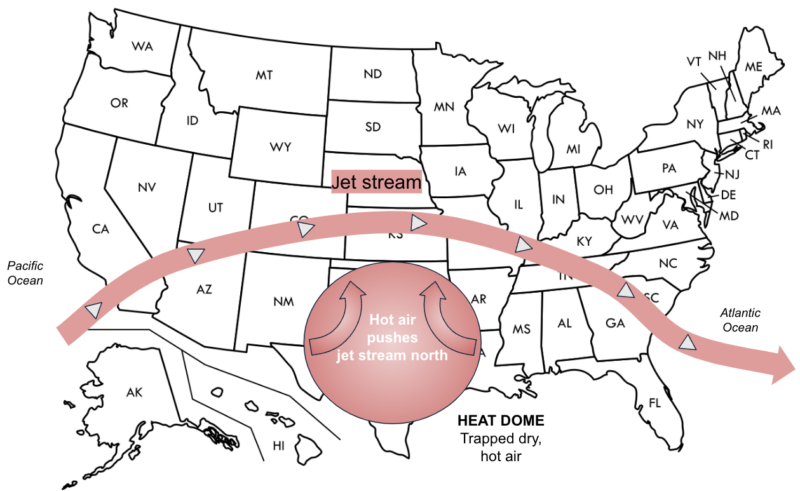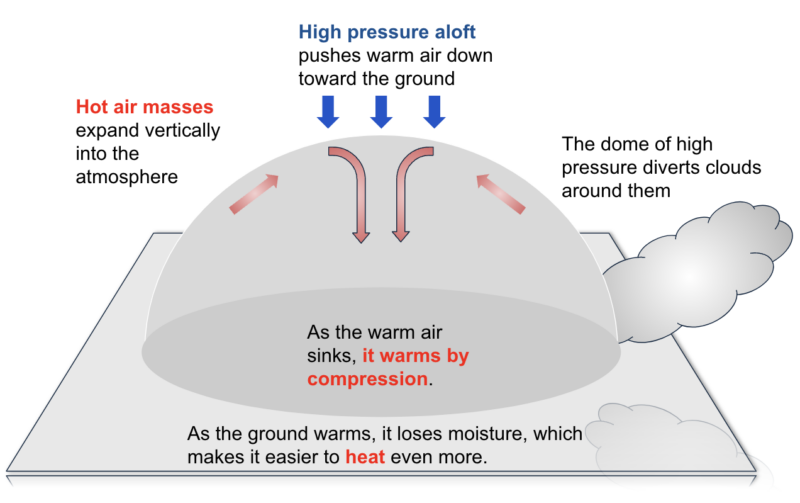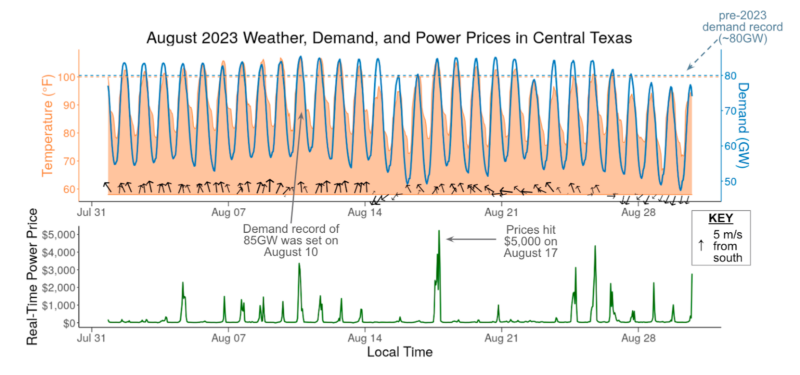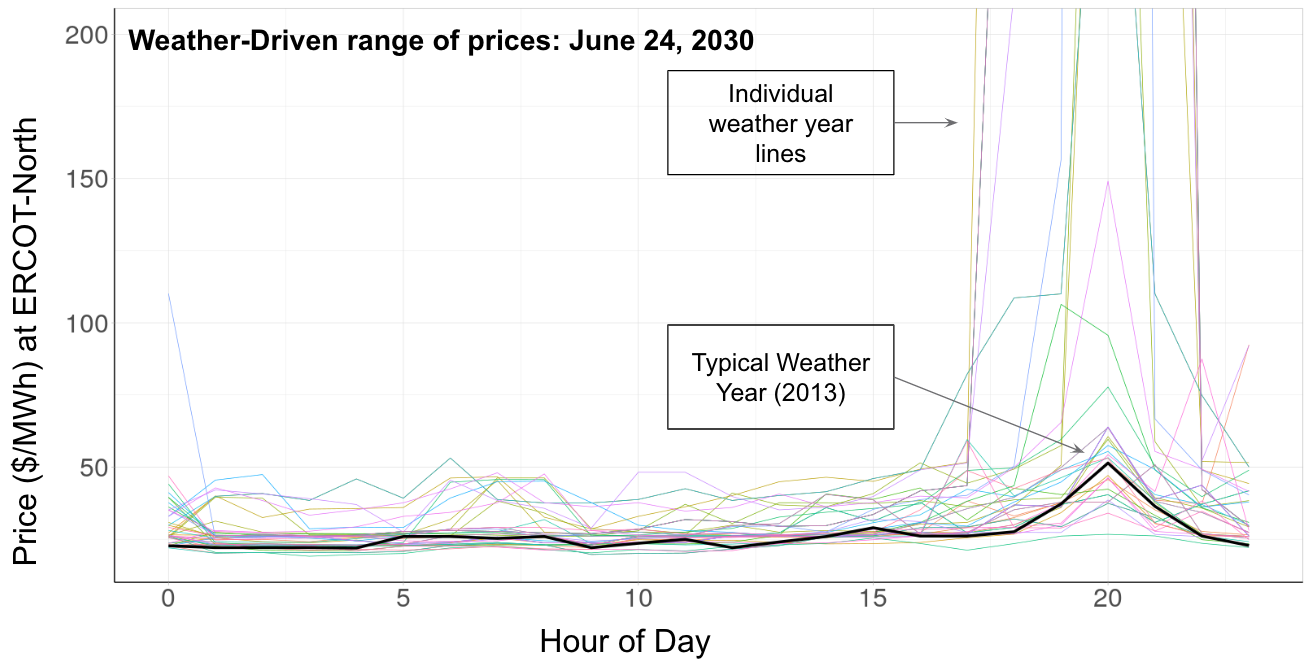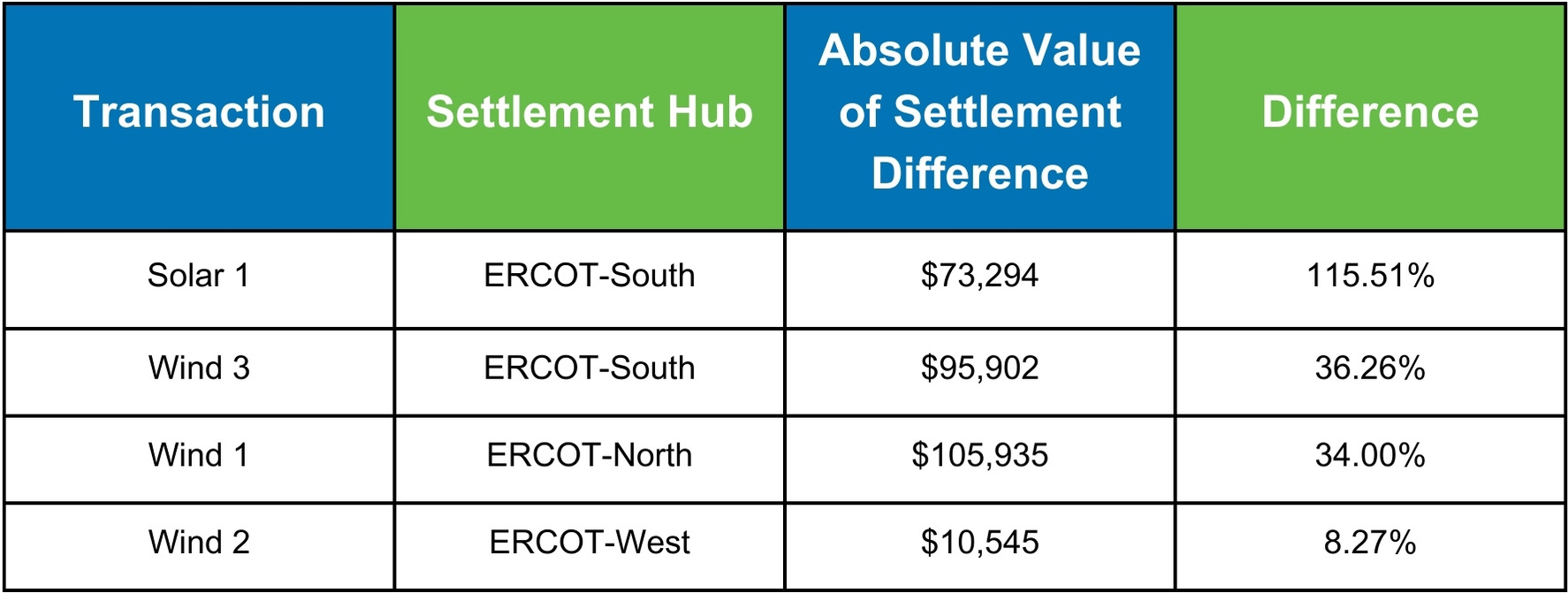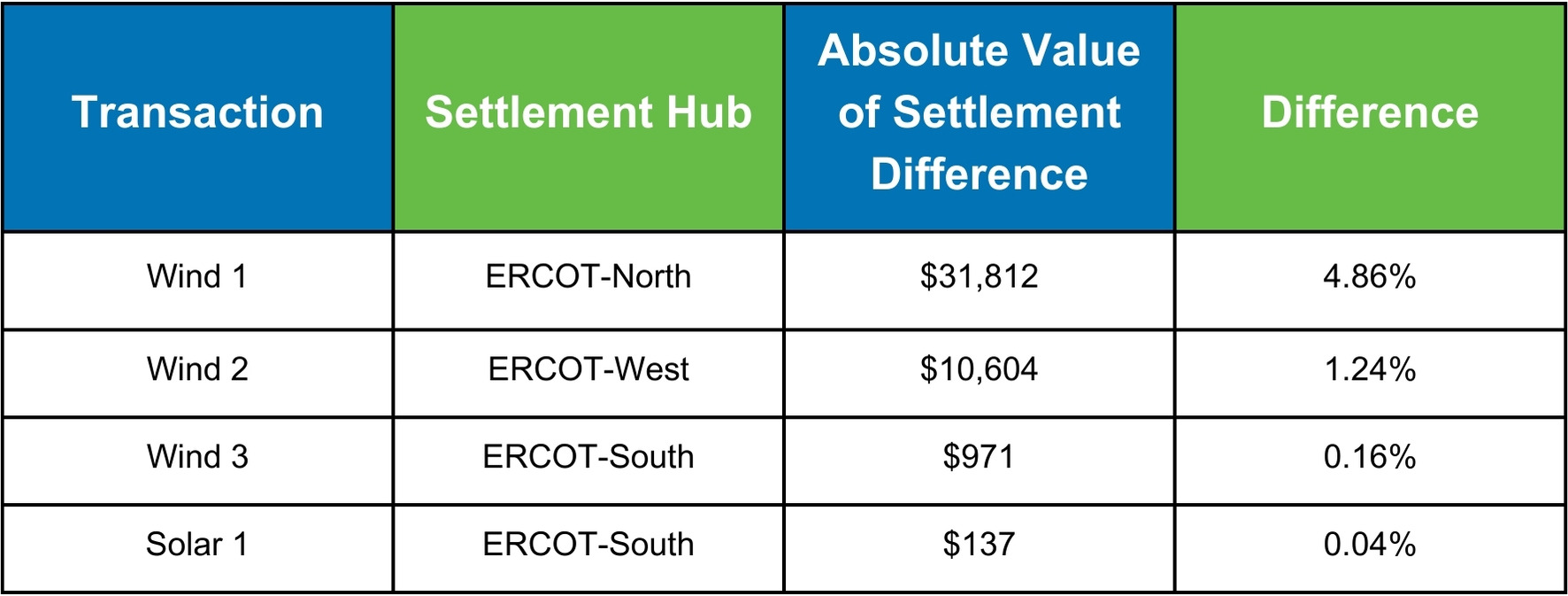Jennifer Newman: Okay, thanks everyone for joining the webinar this afternoon. My name is Jennifer Newman, I lead the Atmospheric Science Research team at REsurety. And I’m joined today by Jessica Tomaszewski who is a Senior Research Scientist at REsurety.
So just to give an overview of what we’re going to cover today, we’re going to start with a background of REsurety and then we’ll dive into the 2023 summer heatwave. We’ll talk about what caused it, what impact it had on demand and renewable energy production in ERCOT. We’ll then talk about whether we can expect more frequent heat waves in the future as a result of climate change. And finally, we’ll discuss how you can take extreme events like this heat wave into account for price forecasts. Finally, we’ll leave some time at the end for Q&A. So as a reminder, everyone except for Jessica and myself are muted, but you can put questions into the Q&A box, and we will address them at the end of the presentation.
So just to give an overview of REsurety – REsurety provides software and solutions for those in the clean energy industry to help them meet their financial and sustainability goals. And although we are a solutions provider, we also spend a lot of time into the data that underlies our solutions. So we have in-house experts in atmospheric science, power markets, and data science, and we’ve supported over 10 gigawatts of renewable energy transactions with our proprietary weather data, or hourly generation models, our power price forecasts and our hourly emissions data.
REsurety provides its customers with a software platform that provides data-driven insights in different parts of the project lifecycle, ranging from initial procurement all the way up through portfolio management. So starting at the left, our Project Explorer tool is aimed at that initial prospecting or procurement phase. This tool provides metrics on generation, financial value, and emissions impact for all operational wind and solar projects in the United States, as well as metrics at hypothetical indicative project locations. Moving along to the middle, the Project Evaluator tool is aimed a little bit further along in the project lifecycle, and this allows the user to provide specifics about their project or their contract, and then simulate the value risk and environmental impact of that contract. So as an example, this tool could be used to rank projects in an RFP by their environmental impact. And then finally, on the right, our Portfolio Tracker tool is for projects that have become operational already. And this allows the user to track and audit their contracts, as well as visualize portfolio-level metrics in a single dashboard.
So at this point, I’ll hand it off to Jessica to give an overview of the summer 2023 heat wave.
Jessica Tomaszewski: Great, thank you for that introduction. To kick us off, I’d like to start with an interactive poll question to get us primed for thinking about heat waves. Feel free to respond to the prompt that should pop up on your screen with your answer to the question, “Was 2023 Texas’s hottest summer on record?” Seeing quite a few responses coming in already. We are actually split so far, about 64% of you are saying yes, 2023 was Texas hottest summer. 40% now saying no. Bobbling back and forth a bit there. I will go ahead and stop that. Final results: split, 60% saying yes, 40% saying no. I think I can actually share the results there.
But the answer is no, it was not. Texas experienced its second hottest summer in 2023 as denoted by this plot here that is ranking each state’s 2023 summer against its respective 129 year history of summers. So you can see that while much of the South had summers classified as much warmer than average, only Louisiana experienced its hottest summer in 2023.
And so that brings me to my second poll question and another test of your memories here. Which year was actually Texas hottest summer on record? And you should be prompted with another poll question here. Your options are 2019, 2011, 1988, or 1980. Getting some responses in. Looks like we’re split between 2019 – oh, 2019 is pulling ahead. 40% responses are voting for 2019, 26 and 23 voted for 2011 and 1980, respectively. I’ll go ahead and end that, share the results with you there. Looks like the winner in our poll here for what is Texas’ hottest summer, landing at 2019, and you would be incorrect.
2011 is the hottest summer on record for Texas, which is what is denoted here in this plot. This is showing a time series of each summer’s average temperature, with 2011 as the reddest dot there on top, with an average June, July, and August temperature of 86.8 degrees Fahrenheit. Coming in second is this past summer that just occurred in 2023, with an average summer temperature of 85.3 degrees Fahrenheit. This constitutes an average temperature of four degrees warmer of the 20th century average, which is that horizontal gray line shown there at 81 degrees Fahrenheit. And temperatures in the 80s might not sound terribly hot, but I just want to keep in mind here that these averages include nighttime temperatures. So if you’re thinking about an 85 plus degree summer over the course of three months, that makes for an impressively warm summer. And for additional historical context, only four summers have been cooler than that horizontal line, that 20th century average, since the last 23 years.
Such extreme heat can have severe or even deadly human impacts. So tools like air conditioning can help people stay safe and comfortable, and as more homes become cooled by AC, powering these units does require significant energy from the electrical grid, which in Texas is largely operated by an entity called ERCOT, to meet that demand.
This relationship between hot temperatures and energy demand can be seen in this hourly time series at a point taken in central Texas over the month of August. Temperature is shaded in orange, and I’ve added a horizontal line at about 100 degrees Fahrenheit to draw attention to just the sheer number of consecutive 100 plus degree Fahrenheit days that occurred. Plotted on top of temperature is the demand in blue with the pre-2023 demand record of 80 gigawatts dashed horizontally just to emphasize how many times we did surpass that record in 2023, and then call attention to August 10, which set a new demand record in ERCOT of 85 gigawatts. These high temperatures and high demand led to high power prices as well, which is seen in this green line of real time prices at a nearby hub on the bottom panel there. Prices surpassed $1,000 per megawatt hour several times and even hit $5,000 on August 17.
As mentioned, the summer of 2023 set the new record for energy demand of 85.5 gigawatts, which represents about a 7% jump from the highest demand day last year. And despite 2011 holding the record for the hottest summer, its peak demand actually ranked seventh in history, it’s not the highest demand day, which indicates that there’s been a large increase in energy demand from growing population, growing infrastructure, that’s occurred over the last decade.
So next, I want to talk through the meteorological conditions that led to the heatwave. And to do so I want to first review a quick intro to atmospheric dynamics. It’s important to keep in mind as we talk through these processes that the atmosphere is a three dimensional fluid, and the upper layer affects the surface conditions and vice versa. So we’re really going to be thinking about a column of atmosphere here when we talk about the dynamics. An important feature of the upper layer there that I’ve denoted is something called the jet stream. When the jet stream takes on a wavier shape, as it’s doing in the schematic, you see troughs and ridges start to form which drive and impact the weather at the surface below. Troughs are known for causing more unsettled weather conditions like warm fronts, cold fronts, thunderstorms, precipitation, but today we’ll actually be focusing on the seemingly less exciting feature here known as the ridge in the jet stream, which I’ve highlighted a pink there. Ridges form when the jet stream works northward, in the Northern hemisphere at least, and are associated with warm air, clear skies, sunny conditions, and high pressure a lot up at the upper levels of the atmosphere. This acts to suppress clouds, suppress storms, and just make for fair weather conditions at the surface. And these features of the jet stream – these troughs, these ridges – are properties that can be seen on weather maps, or pressure fields – various ways to view these features. But basically what we’re going to do is take a horizontal slice of the atmospheric column and we’re going to be looking at a horizontal slice in the upper levels next.
Here, what you’re looking at is this shading on an upper level atmospheric map that represents something called the geopotential height, which is not a term or quantity or value you really need to worry about too much. But what this value is is averaged over all of the Julys and Augusts between 1980 and 2023. And we can use the value to infer the location of the jet stream. In a typical summer, as I’m showing here, this ridge in the jet stream forms over the southwestern United States, which drives that sunny, dry weather, often associated with the summer months. Pretty typical summer situation plotted here on the left.
In the summer of 2023, the ridge in the jet stream was particularly amplified, which eventually leads to the creation of the heat dome, which I’ll explain the meaning of next.
In this schematic you can see where the general location of the heat dome set up. It basically consists of the presence of extreme, persistent heat, over a particular region. Now I’ll break down exactly how a heat dome forms, how it sustains itself, how it progresses.
So a key feature of a heat dome is that it’s self sustaining. It’s fueled by its own impacts, which is what this graphic is illustrating here, courtesy of the Washington Post. What happened in the summer of 2023 is that a stronger than typical ridge formed in the jet stream, which caused those nice sort of fairweather, sunny, clear sky conditions to form, which allows the sun, in the summer months, to continue to heat the surface, raised the temperatures, and form a hot air mass. And so you see this red bubble here representing the hot air mass. As we know, heat expands, heat rises, so it forces that atmospheric column that I mentioned before to also expand in this hot bubble situation that you’re seeing here in the schematic. At the top of that heat dome, high pressure starts to form aloft. That high pressure will actually sort of act to push the air in the bubble back down towards the ground. If you remember anything from your thermodynamics classes about the ideal gas law, you will remember that compression of air towards the surface will lead to compressional warming. So we have a combination of clear skies, ample sunshine, and compressional warming now acting to warm the surface even further. With this high pressure aloft, it’s also acting to divert clouds, thunderstorms – anything that would sort of help bring the temperatures down is being prevented by the heat dome itself. As the heat dome continues to get hotter, it will be able to evaporate more moisture out of the soil and that allows the ground to heat even further. As the ground heats further, the heat dome gets hotter, the ridge builds further northward, and allows even more heating to happen. And so this feedback loop will just continue to persist, which is what makes heat domes so persistent and stagnant. And what I want to do now is focus a little bit more on the bottom piece of the feedback loop, as soil moisture provides a seemingly subtle but key component here to the formation of the heat dome.
And so this next schematic is illustrating this exact idea, the importance of soil moisture and sustaining heat domes. In the image on the left, you can see that when the ground is wet, the sun’s energy can be used both for raising the temperature, which is what’s shown in the red there, and for evaporating moisture. So the act of evaporating moisture is latent heat, which means you don’t actually feel that energy as temperature, as heat. The surface experiences it as moisture from the ground being evaporated into a vapor form. And so that doesn’t actually raise the temperature. So moist soil can help keep temperatures feeling cooler, which is why when you step on your hot driveway, it feels very hot, and you walk back on your grass that it’s a bit of relief, it’s a bit cooler. However, on the right, we get more of this hot driveway situation where when the ground is dry, less of the sun’s energy will be used for evaporation, which means more of it is available to directly raise the temperature. And so this acts as a feedback loop in itself. So as the ground gets hotter, it evaporates more moisture, which makes the ground drier, which makes the temperatures hotter, which just continues to fuel this heat dome.
And as seen in August of 2023, mean temperature and precipitation percentiles are showing that parts of Texas experienced record drought alongside the extreme heat, which just furthers this story of how the heat dome played out here in 2023.
Texas isn’t the only area that experiences heat domes. And in fact, the last major occurrence of one in the United States was in June of 2021. You probably remember hearing news reports of an anomalous ridge also then setting up in the jet stream, in a particularly unusual location over the Pacific Northwest, which caused record heat, severe drought, and wildfires, which we experienced the downwind impacts of over much of the United States.
So now I will pass it back to Jen to discuss the impact of heat waves on demand and renewable energy generation.
Jennifer: Right, so there’s a pretty obvious relationship between demand and temperature. So just to show that with a little bit of data, this plot here shows ERCOT-wide demand on the Y axis and cooling degree days on the X axis. Cooling degree days are a measure of how many degrees you would need to cool your home in order for it to feel comfortable. So the higher that cooling degree day metric is, the warmer it is outside. So if you look at this scatterplot, there’s that obvious relationship where when you had higher temperatures, the demand tended to be higher as well. And all of those dark red circles are experienced in August, also highlighted that peak demand record day on August 10, but there is a little bit of scatter here where you can have a similar temperature, but different values of demand. And that’s because there are other non-temperature factors that also impact demand. Things like the relative humidity, the wind speed, or whether it’s a weekday or a weekend.
What’s also fairly obvious is the impact that heat wave is going to have on solar generation. So this map here shows the August 2023 solar irradiance anomaly. So what this is telling us is how sunny was it in different parts of the country in August 2023, compared to a typical August. So if you look at Texas, you can see that a lot of it was pretty far above average in terms of the solar irradiance. And that’s because we had this heat dome in place, we didn’t have much cloud cover, we didn’t have storms coming through, so the sun was shining almost all the time and we had really high solar generation values as a result.
So what’s not as obvious is the impact that heat waves have on wind generation. So I’m going to pose this to the group. So this is our next poll question: what impact do heat waves have on wind generation? You should see that popping up in just a second. All right, so what impacts do heat waves have on wind generation? Do they increase wind generation? Are they actually good news for wind? Do they decrease wind generation? Or does it depend? Alright, so about half of you are saying they decrease wind generation, some people are saying it depends. Give everyone a couple more seconds. All right, so I’m going to end that and share the results. So the winning answer was that heat waves decrease wind generation. The answer is actually that it depends. If the answer was more straightforward, then this section would be a lot shorter, and you wouldn’t have to listen to me. But I’ve already got the slides ready, so we’re going to talk about why it’s a little bit more nuanced.
So now we’re looking at a similar map, but for the August 2023, 100 meter wind speed anomaly. So this is telling us how windy it was in different parts of the country compared to a typical August. So looking at Texas again, you can see there were some parts of Texas where it was actually more windy than usual. And because this is compared to a typical August doesn’t necessarily mean it was super windy, it just means that compared to how August typically looks in Texas, it was a little bit more windy than usual. So next we’re going to talk a little bit about why people might think that heat waves are going to decrease wind generation.
So there is somewhat of a link between extreme temperatures and low wind speeds. And that’s because both extreme temperatures and low wind speeds are associated with a common atmospheric phenomenon, which is a high pressure system. So when you have these high pressure systems in place at the surface, they tend to divert clouds. You don’t have a lot of storms moving through or cloud cover. So temperatures can get fairly extreme, either very warm or very cold. And in addition, these air masses tend to be very stagnant. You don’t have these storm systems coming through bringing gusty winds. So you tend to have fairly low wind speeds when you have these high pressure systems in place. This was actually exactly what we saw during winter storm Uri in 2021. So if you look at the left figure, this is a sea level pressure chart during that February 2021 event. So there’s a big high pressure system in place at the surface. And now looking over at the right, this is zoomed in at 80 meter wind speeds in Texas. So some of those shaded areas that are the lighter or darker blue are areas where the 80 meter wind speed was below five meters per second. And this is barely above the cut in of a wind turbine. So during that event, we had this high pressure system, we had really cold temperatures, and we had fairly low wind speeds.
But you don’t always have these high pressure systems in place during these extreme temperature events. And to compare and contrast here, I’ve shown the sea level pressure for both winter storm Uri on the left, and the summer 2023 peak demand day on the right. And even if you’re not a meteorologist, you can tell that the colors and these figures look a little bit different. So on the left for winter storm Uri, we had, again, this big, high pressure system in place, that really stagnant air mass with low wind speeds. And then in contrast, during the peak demand day from this past summer, there was actually a low pressure system that was moving through Texas. And in fact, there were several days in August when the Weather Service issued red flag warnings for wildfire risk because we had fairly breezy conditions. So why didn’t we have these really stagnant, low wind speed conditions during the heat wave this summer?
So the answer comes down to how pressure at the surface reacts to either a very cold air mass or a very warm air mass. So when you have a really cold air mass, like we had with winter storm Uri, all of that cold and dense air sinks, and then it builds up at the surface. So you can see all those little air particles building up at the surface. And all of those building up air particles are going to make that surface pressure even higher. So that’s going to deepen that surface high pressure system and kind of enhance those stagnant weather conditions.
But something different happens when you have a really warm air mass. And that’s because warm air tends to rise because it is less dense than cold air. So when you have a really warm air mass in place like we did this summer with the heat dome, all that warm air is going to tend to rise which is actually going to lower the surface pressure. So we don’t really have this kind of feedback loop with that surface high pressure deepening like we do during these cold air events.
So the key takeaway here is that those surface high pressure systems that we associate with low wind generation are going to tend to be more persistent during cold weather events versus warm weather events. So we aren’t always going to see these persistent high pressure systems when we have these heat dome events.
So next, we can dig into what wind generation actually looked like this summer. So this scatterplot shows the cooling degree days again on the X axis. And on the Y axis, I’m showing the daily ERCOT wind generation minimum. So this is telling you the lowest level that ERCOT wind generation dips throughout each day. So what you can see is that there’s not really much of a correlation between how hot it was and how low or high the wind generation was. And you can have times when the temperature was fairly similar, but the level of wind generation was very different. Just to add a little bit more detail here, this top dashed line shows the ERCOT low wind scenario. And the bottom dashed line shows the ERCOT extreme low wind scenario. And these are scenarios that ERCOT planned for going into this summer, in order to make sure that they could meet demand. So if they had really high demand and wind was very low, they wanted to make sure they would have enough resources to meet that demand. So there were a handful of days this past August where the wind generation did dip below that low wind scenario. But all of these days took place toward the end of August and there are actually some relatively windy days toward the beginning of August. So next we’re going to zoom in on a couple of days that had pretty similar temperatures, but very different levels of wind generation. And we’ll look at how that impacted the price of power.
So we’re looking here at ERCOT demand on the top, ERCOT wind generation in the middle, and then the ERCOT West real-time price on the bottom. And we’re showing the same hourly plots for August 14 in blue and August 17 in green. So what you can see is that although the peak demand and the afternoon demand profiles on both these days looked very similar, the wind generation was very different on each of these days, with the wind generation being about twice as high on the 14th as compared to the 17th, the 17th did kind of dip to that low wind scenario. So as a result, the prices on August 17, were much higher and reached the market cap of $5,000 per megawatt hour. And that’s because we didn’t have this really low cost generation source in the wind available. So more expensive generators had to be brought on line to meet demand and that increased the price of power. So a key takeaway from this section is that the wind generation isn’t always going to be low on hot days, although it’s obviously important to plan for the scenario where it might be, because that’s obviously going to impact the price of power.
Alright, so I’m going to hand it back to Jessica to talk about why we can expect more frequent heat waves in the future.
Jessica: Sounds good. So before we think about the future impacts of heat waves, let’s think about the recent history. And we’ll do so with another poll question, I believe our final one. True or false: heat waves have become more common in recent years? Go ahead and respond to the pop up you see there. Some falses, some truths. Looks like we’re trending towards true being our answer. I’ll share the results here. We’re at 86% of folks saying that is true, heat waves have become more common in recent years.
And those 86% would be correct. The average amount, length, and intensity of heat waves have steadily increased in the U.S. since the 1960s, which can be seen in this plot on the left showing the average number of heat waves per year. And in the plot on the right, where you’re looking at the upward trend and cooling degree days, which is as Jen mentioned earlier, is a representation of how hot a day is compared to a standard temperature like 65 degrees, that number has been trending upwards in the last few decades, indicating that heat waves have become more more frequent and intense these last several years.
Scientists have used climate simulations to visualize this increase in extreme heat wave events as the Earth warms due to global warming. So they first defined a heat event, or they first identified a heat even,t during this pre-industrial period, which is defined as the years between 1850 and 1900, or before the impacts of human warming started to take place, and identified an event that had temperatures so high that they were only reached one time over a given land area during those 50 years. Thus, constituting a literal 1 in 50 year event. And that 1 in 50 year event is denoted on this horizontal bar as this orange box there just to give a visual of what that looks like. So during the baseline period, a 1 in 50 year event is shown by that one orange box, or a 2% likelihood of occurrence. If we look at the last several years, 1980s through now, the average global temperature has increased by one degree Celsius since that pre-industrial period. And simulations now see that that type of heat wave, that 1 in 50 year event, or an event that used to happen only 1 in 50 years, now happens 5 times in 50 years, you see those five orange boxes there along that horizontal gray line. These climate simulations can then be projected forward with potential global warming scenarios. And we can see that as the Earth continues to warm, extreme heat becomes more common. Even if the world can meet its goal of limiting warming to 1.5 degrees Celsius, extreme heat waves are likely to be almost twice as likely as they are today, and nine times more likely than they once were, and those probabilities only increase as global warming increases, as you can see with those subsequent horizontal lines and the many more orange boxes that begin to appear.
The physical drivers of the projected increases in heat waves are of ongoing discussion in the scientific community. One factor is the increase in soil drying. So as I mentioned before, the feedback loop between soil moisture and temperature is extremely important, especially considering heat wave events. So as the Earth warms, there’s more heat available in the atmosphere and that additional heat available will allow more moisture to evaporate out of the soil, which will amplify that effect of solar radiation on the surface temperature which dries out more soil and just perpetuates that feedback, making heat waves more intense, more stagnant, and have more severity. Another potential element driving increased heat waves in a changing climate is the destabilizing of the jet stream, or wavier jet stream, and that idea is shown in the schematic on the right. As the Earth warms, there’s more heat in the atmosphere, and that heat may result in atmospheric dynamic responses that destabilize the jet stream and cause more anomalous and persistent ridging that acts to create and sustain these heat domes. The flip side of that is that this type of mechanism, this wavier jet stream, can also allow for more intense polar air intrusions as well. So you probably remember, we discussed earlier, winter storm Uri back in February 2021 was a result of a destabilized jet stream. Future warming could impact the jet stream enough to allow for events like that to happen with increasing severity.
And finally, I will return the mic back to Jen to discuss accounting for extreme weather events in your power price forecast.
Jennifer: Okay, so now that we know that these extreme events are likely to become more frequent, we’re going to talk about how you can take them into account when you’re forecasting the price of power.
So we’ll first talk about why it’s so important to capture these extreme events. And that’s because these extreme weather events tend to have a pretty extreme impact on the price of power. That’s both because they increase demand and they can also impact the generation that’s available to meet that demand. So to kind of see how extreme events have impacted the price of power in the past, I’m showing here the monthly average price of power in ERCOT West. So you can kind of pretty easily pick out when some of these more extreme weather events have occurred. So you can see when the August 2011 heat wave occurred, and again, that was the hottest summer on record for Texas, there was that heatwave in August 2019, February 2021, winter storm Uri is basically off the charts, I’ve kind of put an arrow there showing where the price would be. There was a smaller heat wave last summer in July that led to some high prices, and then again, that August 2023 heat wave. So you can see for the majority of this historical period, the prices are kind of between $25 and $50 per megawatt hour, but they can be two to three times as high as that when you have these extreme weather events. And importantly, the status quo in the industry is to assume that you’re going to experience these typical weather conditions in the future. This is known as the 8760, or typical weather year approach. And when you’re doing that, you’re basically assuming that you’re going to have these kind of normal average power prices when we can see that that’s obviously not the case all the time.
So what REsurety does is instead of using a typical weather year to power a power price forecast, we use a variety of different historical weather conditions. And to show the value of this approach, this plot shows the hourly forecasted price of power for a June day in 2030. So the black line denotes the price of power that we forecast if we assume weather conditions resemble a typical weather year of 2013. And all of those individual colored lines indicate the power prices that we forecast based on different weather conditions. So you can see depending on what weather conditions you expect, you can have much higher prices of power.
So next we’re going to take that weather variability approach to forecasting power prices for August 2023. So this blue bar shows the range of power prices that were forecasted as part of REsurety’s Q3 Weather-Smart forecast. And this forecast takes weather conditions from 1980 through 2022 into account. So this is basically pretending that we’re at the beginning of the summer so we don’t know what the weather in August is going to be like, but what can we forecast based on weather that we’ve experienced in the past. So again, that blue bar shows the range of power prices that were forecasted and each of those green lines denotes the forecast from a particular weather year. And the actual August 2023 price was about $200 per megawatt hour. So it is on the tail of the distribution, but it isn’t the highest price that we actually forecasted. And that award goes to August 2011. So if we took August 2011 weather conditions and put them in the grid of 2023, we would forecast a higher price of power of $220 per megawatt hour. And that’s partially because August 2011 was hotter than 2023, as we discussed, and it was also less windy than 2023. And both of those factors would lead to higher power prices. So again, going into the summer, we didn’t know exactly what the weather was going to look like but by including this large range of weather conditions, including some extreme events, we were able to see that an outcome like August 2023 was indeed possible going into the summer. And then if you use that typical weather year approach you would get that purple circle. So you would only forecast $70 per megawatt hour for August. So again, this is assuming that you’re experiencing average temperatures, average wind speeds. So you’re definitely going to underestimate the potential volatility that could be experienced this summer if you just assume these typical meteorological conditions.
So just to close with some key takeaways, in 2023, Texas experienced its second hottest summer on record, second only to 2011. And a new peak demand record of about 85 gigawatts was set. The heat wave was due to the heat dome, which was a region of warm air that can get trapped over the surface for days or weeks at a time. During the heatwave solar generation tended to do pretty well while wind generation was variable, it kind of depended on the day. A heat wave like the one we experienced this summer are expected to become more common in the future as a result of climate change. And you can take extreme events like this heat wave into account in your price forecasts by making sure you incorporate a variety of different weather conditions into your price model rather than just a single typical hydrological year.
So that ends the content of our presentations, we’re going to move to questions now. So feel free to put any questions you have into the Q&A, and we’ll start to answer those.
Jessica: Great. So one question I’m seeing here is that we’ve spoken quite a bit about 2011, which was Texas’ actual hottest summer on record. Was that event the result of a heat dome as well?
And I can show you on slide 59, what 2011 looks like in that same slice of the atmosphere that I showed you back when we were talking about 2023. So the short answer is that 2011 was also a heat dome event over Texas. You can see there that the summer of 2011 jet stream, while a bit less intense and less amplified than in 2023, it was actually much wider in size and more persistent in duration. So this is an average from June, July, and August of 2011, and you can see just this big blob of high pressure in those upper levels of the atmosphere, which caused persistent heating and drying of the soils. So I’ve also included the drought monitor from August 30, 2011. You can see just this massive blob of red over Texas, indicating just how intense and persistent that heat dome that year was.
Jennifer: Alright, we had another question come in. Can I see the same analysis for weather in other markets, for example, in SPP?
So the answer is yes. REsurety uses what we call our Weather-Smart approach, where we use this variety of weather conditions and our power price forecasts for all of the ISOs where we produce power price forecasts. And currently we have coverage in six of the seven U.S. ISOs, and we’re looking to add the seventh very soon.
Alright, I’m going to the next question. What was unique about August 17 that led to power prices hitting the $5,000 per megawatt hour price cap, as opposed to that many other high demand days last summer?
So as I discussed a little bit earlier, there’s some other non-temperature dependent factors that also impact demand. So if it’s very humid, that’s going to drive up demand. And it also depends on what generation sources you have available to meet that demand. In the case of August 17, again, the wind generation was very low. And because that is a fairly inexpensive source of generation, and it wasn’t necessarily there on August 17, more expensive generators needed to get used on that day and that drove up the price of power. So that’s kind of what made that day a little bit different from some of the other days when temperatures were very high.
Jessica: Looks like we have a question here on the relationship between wind and temperature. Does this relationship depend on other factors? Can we not assert a direct or inverse correlation between these two variables?
And I think the short answer here is that weather conditions at the surface are really complicated and there’s not a direct influence between temperature and wind. Wind is driven, as Jen mentioned in her portion of the presentation, wind is driven typically by pressure differentials across the surface. So my plot on slide 15 that shows the impact the jet stream has on the surface conditions, you can see that there are surface fronts there, there’s warm fronts, there’s cold fronts. Those types of intense differentials in temperature and pressure at the surface will drive more of your wind speed anomalies as opposed to just temperature by itself. So what you really need is an area of warm temperature and an area of cold temperature sort of in proximity to drive a pressure gradient between them and that’s what’s going to fuel wind.
Jennifer: And actually, if we go to slide 58 in the appendix, I actually did do a little bit of analysis, seeing if you could find a correlation between temperature and wind generation in ERCOT. So we call these plots the fuzzballs because there’s a lot of scatter in them. What this is basically showing is for each month, so there’s 12 plots here, what does a representative portfolio capacity factor look like in ERCOT as a function of the average five day temperature? So this is kind of looking at over the duration of five days are you tending to see these really cold temperatures and then a few days of also very low wind speeds. And what you can see is that in some of the colder months, so the top couple panels of January and February, there is somewhat of a relation, there’s a lot of scatter there, where you do tend to see lower wind speeds, lower capacity factors with those colder temperatures. And this is probably because of those stagnant high pressure systems that tend to be more common in the winter. But then when you look to the summer months, so like July and August, that’s where you really see a lot of the scatter in that relationship kind of breaks down because there are other factors that are going to impact the capacity factor. So there is somewhat of a relationship, but it’s primarily just in the winter months and that’s because of the prevalence of those stagnant high pressure systems.
Another question, I’m wondering how users of the power forecasting tool typically make use of the distribution of prices based on historical weather years. Do you try to estimate likelihood of occurrence of each weather year or do you just provide the distribution and leave interpretation to the user?
So that’s a great question. And what we typically do is we provide quantiles. So we’ll provide a P50 of a price forecast or a capture rate across all those weather years in addition to a P99, P1, etc. And what we found is our customers tend to use this in kind of a stress test scenario. So they want to see how can I plan my budget or adjust my risk accordingly so that if this kind of P99 scenario does happen, how can I kind of adjust for that? So that’s kind of typically how we’ve handled it, instead of just presenting this whole distribution, we’ve given quantiles just to give an assessment of what are the best and worst case scenarios.
Alright, another question. Why does wind generation typically tend to be low in the afternoon? So Jessica, do you want to take that?
Jessica: Yeah, sure. So I think we showed some plots showing a typical day cycle of wind generation over the course of the day. Wind is typically low in the afternoon, because the sun is fully up and at its highest point, and is heating the surface of the earth and causing the sort of overturning of the air, which atmospheric scientists refer to as “mixing” often. And what that’s doing is spreading out the wind speeds throughout the atmospheric column that I mentioned. Wind actually ramps up in the evening hours, especially in the southern plains of the United States, due to a phenomenon known as the low level jet. The low level jet tends to set up during the nighttime hours due to dynamics that occur over the southern portion of the U.S. and cause amplify wind speeds just a little bit above the surface. So at about the point where we build wind turbines. And then as I mentioned, that wind will persist throughout the night and then as the sun comes up, will sort of erode those higher winds away so that during the day, those winds aren’t available for wind turbines to extract energy from.
Jennifer: Alright, and we’ll just answer one more question before wrapping up. Is this information – I assume information on the power price forecasts – only available ISO-wide or can you look at a specific renewable asset to see how it performed in extreme weather events?
So yes, we do modeling at specific renewable energy assets. So we take all of that weather data, and we look at not just what was the impact of that weather on demand and the price of power, but also how does that impact generation at a specific renewable energy asset. So we can then look at what is the risk profile of that renewable energy asset and how might it perform with these extreme weather events.
Alright, so at this point, we’re going to wrap up. So thank you everyone for attending the webinar. We really appreciate all of your attention and all the great questions. Thank you.





